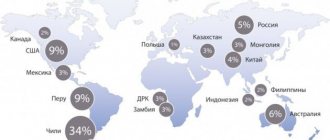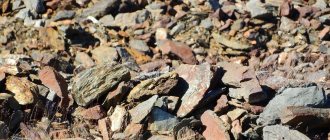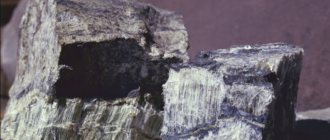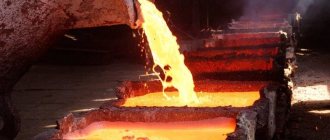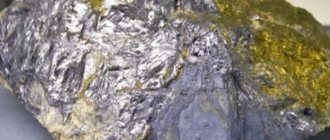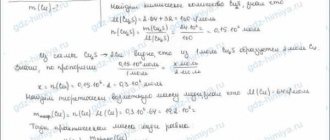Deposits on the world map
The largest ore reserves are located in Chile - 34% of the world's total. The USA and Peru each have 9% of fossil deposits. Eastern Siberia, the Urals and the Kola Peninsula account for 5% of the deposits.
The world's copper deposits are located on the African continent, South America, Canada, and Australia. Of the European countries, Poland is the richest in them. There are known deposits in China and Mongolia.
Porphyry and vein deposits are located in the Western Pacific belt and Mediterranean regions. Kazakhstan, Armenia, and Uzbekistan have them.
Map of copper deposits in the world
Varieties of copper ores
Ore classification according to genetic and geological characteristics:
- stratiform - these are sandstones and shales;
- pyrite - vein copper and nuggets;
- hydrothermal - it is called the porphyry copper form;
- skarn rocks;
- igneous - this ore contains nickel;
- carbonate - have an iron-copper and carbonatite composition.
Natural minerals containing copper
Bornite. Sulfide ore, its composition is determined by the expression Cu5FeS4. There are two polymorphic types - low-temperature and high-temperature. The melting point of which, respectively, is less than or greater than 228 degrees.
There is an early unstable sulfide that is easily destroyed by water and wind. The other type is endogenous, and has a variable chemical composition due to admixtures of elements such as galena, pyrite, chalcocite, and chalcopyrite. Bornite is called variegated pyrite. The characteristics of these minerals depend on their origin.
Chalcopyrite. The formula CuFeS2 determines its composition. Known as copper pyrite. Refers to polymetallic. It can exist in the form of skarns and mountain greisen.
Chalcocine. Contains 79.8% copper and 20.2% sulfur. Very beautiful, the mirror surface has a grayish tint, sometimes black.
There are rare fossils containing copper elements:
- cuprite (Cu2O), an oxide, is seen among deposits of malachite and nuggets;
- covellite, contains 66.5% of the main element and sulfur. First found surrounded by the Vesuvius volcano. Mined in the USA, Greece, Chile;
- malachite. A stone that is used for various crafts. Polymetallic ore. Nizhny Tagil is the place of large deposits of this mineral;
- azurite This is azure, a blue stone. The main places of its production are Africa, Australia, England, and the Balkan countries. Occurs near sulfide deposits.
Porphyry copper forms include molybdenum, gold, chalcopyrite, and pyrite. They are found in deposits of poor rocks. They have the form of veined stockwork-type inclusions.
COPPER ORES
COPPER ORES, natural mineral formations containing copper in such compounds and concentrations at which their industrial properties. use is technically possible and economically feasible. It is known that St. 170 copper minerals; prom. less than 20 are important, the main ones being: native copper (98% $\ce{Cu}$), chalcopyrite (34.5% $\ce{Cu}$), bornite (63.3% $\ce{Cu} $), chalcocite (79.8% $\ce{Cu}$), cubanite (22–24% $\ce{Cu}$), covellite (66.5% $\ce{Cu}$), tennantite ( 57.5% $\ce{Cu}$), tetrahedrite (52.3% $\ce{Cu}$), cuprite (88.8% $\ce{Cu}$), tenorite (79.9% $ \ce{Cu}$), malachite (57.4% $\ce{Cu}$), azurite (55.3% $\ce{Cu}$), chrysocolla (36.1% $\ce{Cu} $), brochantite (56.2% $\ce{Cu}$). According to their genesis, primary, oxidized, and mixed microorganisms are distinguished; according to mineral composition - actual copper (native copper) and complex (sulfide, carbonate, silicate, sulfate, oxide, etc.). In the primary ores of most industrial processes. In deposits, copper is present in the form of sulfides (chalcopyrite, bornite and chalcocite, cubanite), in oxidation zones (oxidized and mixed ores) it is represented by carbonates, silicates, sulfates, oxides and other classes of minerals. M. r. in deposits mainly complex. Up to 80% of copper is extracted from sulfide ores, the rest comes from carbonate, oxide, silicate and copper itself. In all types of sulfide deposits, in near-surface conditions, complex zones of oxidation, leaching, and secondary sulfide enrichment are formed, in which native copper, chrysocolla, cuprite, azurite, malachite, chalcocite, covellite, etc. are developed.
Deposits of the M. river containing reserves of St. 5 million tons are classified as unique (18 such deposits have been identified, 4 of them are in Russia), large deposits have reserves from 1 to 5 million tons, medium ones - from 0.2 to 1 million tons, small ones - less than 0 .2 million tons. Rich ores contain St. 2% copper, ordinary - 1-2%, poor - less than 1%. Wed. The copper content in mined ores is 1–0.8% (constantly decreasing: in the 19th century ores with an average content of 10% were mined, in the early 20th century – 3.8%). Rich ores are smelted without enrichment, ordinary and poor ores are enriched. The complexity and methods of beneficiation of ores depend on their mineral. composition and textural-structural features.
Average copper content in decomp. types of ores geological-industrial types of copper deposits range from 0.3–6%. The content in them is basic. associated components varies to an even greater extent, amounting to avg. for platinoids, $\ce{Au, Re}$ 10–6–10–4%; for $\ce{Ag, Se, Te, In, Tl, Ga, Ge}$ 10–4–10–3%; for $\ce{Mo, Bi, Cd, Co}$ 10–3–10–2%; for $\ce{Zn, Pb, Ni, R, Ti, V}$ 10–1 – n%; for $\ce{S\:and\: Fe}$ (magnetite) n–n·10%. As harmful impurities in M. p. arsenic and antimony are often found (10–3–10–2%), sometimes mercury (10–4%).
Prom. M. river deposits divided into 6 genetics. groups in which at least 8 main groups are distinguished. geological-industrial types. Among the magmatic ones there are 2 geological and industrial processes. type – sulfide copper-nickel and copper-titanium (or vanadium-iron-copper); in carbonatite and skarn rocks - according to one type, the genetic one of the same name. group; among hydrothermal plutonogenic there are 2 types - copper-porphyry and sulfide-quartz veins; in pyrites - a type of copper-pyrites, in stratiforms - a type of cuprous sandstones and shales. Geological-industrial types are very unequal in their economics. meaning. Among foreign deposits of M. river. Porphyry copper deposits predominate (from 65 to 70% of the world's proven copper reserves), from 15 to 20% of reserves are concentrated in deposits of cuprous sandstones and shales, 5–8% in copper-pyrite deposits, 2–2.5 in sulfide copper-nickel deposits %, in skarns 2–4%, in carbonatites 0.5–0.7%. In Russia the main Three types of deposits are important in terms of reserves and production: sulfide copper-nickel (44.7% of the country's total), copper-pyrite (28%) and cuprous sandstones and shales (20.9%); the remaining types - porphyry copper, iron-copper, skarn, etc. account for 6.4%. Identification of new geological and industrial types of deposits M. river. associated with the development of minerals. ocean resources (for example, stratiform deposits of sulfide copper ores in ocean sediments, sulfide structures).
Porphyry copper deposits are associated with hypabyssal porphyry intrusions of moderately acidic composition. Ore bodies are represented by stockworks of isometric, elongated or complex shapes. Porphyry copper ores have vein-disseminated textures, Ch. minerals – pyrite, chalcopyrite, chalcocite, bornite, molybdenite. The ores are complex, the copper content in them ranges from 0.4 to 1.2%, the average is 0.6–0.7%. Among them, based on the composition of the ores and the ratio of copper, molybdenum and gold, four types are distinguished: proper copper-porphyry and gold-copper porphyry, molybdenum-copper-porphyry, copper-molybdenum-porphyry and proper molybdenum-porphyry. In addition to copper, molybdenum and gold, rhenium, silver and other metals are extracted from ores. The sizes of ore deposits are, as a rule, large, their area is often measured in square kilometers, volumes reach 1 km3 (sometimes more). In unique deposits of this type (Chukicamata, El Teniente in Chile) reserves exceed 20 million tons. There are three planetary belts of distribution of porphyry copper deposits: Pacific (Chile, Peru, Mexico, USA, Canada), in which the predominant part of reserves is concentrated ; Mediterranean (Serbia, Macedonia, Bulgaria, Armenia, Turkey, Iran, Afghanistan, Western Pakistan, Northern India); Kazakh-Mongolian (Kazakhstan, Uzbekistan, in Russia – Tuva; Mongolia, China). Known approx. 150 porphyry copper deposits, among the most famous: Kounrad (Kazakhstan), Kajaran (Armenia), Kalmakyr (Uzbekistan), Peschanka (Russia), Bingham, San Manuel (USA), Valley Copper (Canada), Majdanpek (Serbia) and etc.
Deposits of cuprous sandstones and shales are associated with formations of red-colored, variegated, gray-colored sand-shale, originally sedimentary (sometimes volcanogenic-sedimentary) rocks, which later experienced noticeable transformations as a result of the processes of dia- and catagenesis and under the influence of underground hot mineralization. water Ore bodies preem. sheet-like shape, length and width - from pl. hundreds of meters to several kilometers, thickness up to 30 m (sometimes more). The deposits are characterized by large sizes and are often classified as unique in terms of reserves. The copper content in ores ranges from 1 to 6%, the average is 3.5%. The ratio of ch. ore-forming elements $\ce{Pb\:: Zn\: : Cu}$= 1 : 0.5 : 10. Sulfide ores. The most common miner. types of ores: chalcopyrite-bornite-chalcocite; galena-chalcopyrite-bornite-chalcocite (primary); brochantite-cuprite-native copper-malachite mixed (secondary and oxidized). The textures of the ores are layered-banded and veined-disseminated. Related industrial components – lead, zinc, silver, platinum group metals, rhenium, selenium, tellurium, cobalt, uranium, cadmium, germanium. The largest stratiform deposits are located in the Copper Belt of Central Africa (Nchanga, Mufulira, Nkana and others in Zambia; Kamoto, Musoshi in the Democratic Republic of the Congo), Kazakhstan (Dzhezkazgan), Poland (Legnitsko-Glogow ore field), Afghanistan (Ainak) , Russia (Udokanskoe in the Trans-Baikal Territory).
Copper-pyrite deposits are associated with volcanogenic and volcanogenic-sedimentary basaltoid formations of the early stages of development of fold belts. Massive, disseminated and veinlet-disseminated ores also have a sulfide composition. Continuous massive ores are stacked in the main. pyrite with an admixture of chalcopyrite, sphalerite; sometimes galena, fahlores, and other sulfides are present in small quantities. Disseminated and veinlet-disseminated ores are usually represented by hydrothermally altered sedimentary and volcanogenic rocks with dissemination and veinlets of the same sulfides. There are several types of ores depending on the ratio of the predominant sulfides - chalcopyrite-pyrite, chalcopyrite-sphalerite-pyrite, etc. Copper content - from tenths of a percent to 2-3%, on average. OK. 1.4%. Along the way, zinc, lead, sulfur, gold, silver, cadmium, selenium, and tellurium are extracted from ores. The most famous foreign deposits: Kidd Creek, Flin Flon and others (Canada), Skouriotis (Cyprus), Rio Tinto (Spain), Bessie (Japan); in Russia – Yuzh deposits. and Wed. Urals (Gaiskoe - unique in terms of reserves, Sibaiskoe, Blavinskoe, Uchalinskoe, Podolskoe, etc.) and Northern. Caucasus (Urupskoye, Khudesskoye).
Sulfide copper-nickel deposits are associated with layered intrusions of mafic and ultramafic composition and were formed as a result of liquation. Ore bodies of sheet-like, lens-shaped and irregular shapes, as well as veins. The length along strike and dip ranges from tens to many hundreds of meters. The thickness is many tens of meters. The textures of the ores are disseminated, massive “schlieren”, veinlet-disseminated, breccia. The composition is complex (main ore minerals: pentlandite, chalcopyrite, cubanite, pyrrhotite), in addition to copper, cobalt, platinum group metals, gold, silver, selenium, and tellurium are extracted from them. The most famous deposits: Fruit, Grayton, Thompson, Mystery Lake (Canada), Bushveld Complex (South Africa), Kambalda, Mount Keith (Australia); among the Russians deposits - two are considered unique (Talnakhskoye and Oktyabrskoye in Eastern Siberia).
Skarn deposits are formed in exocontact zones of granitoid intrusions that cut through limestones and calcareous-terrigenous rocks. The calcareous skarns of granite-pyroxene composition that arise under these conditions develop both along the host rocks and granitoids. Prom. ore bodies are located in exoskarn zones at a short distance from the contact. They are characterized by complex morphology, small sizes, and complex composition of ores. Combinations of bornite-chalcopyrite and magnetite mineralization are common in these deposits. The ores are veinlet-disseminated. The copper content is high, but uneven, on average. 1.5–3%. Associated components are iron, gold, cobalt, silver, selenium, tellurium, molybdenum. In Russia, the deposits of the Turinsky group in the Urals belong to the skarn type, for example. Vadimo-Alexandrovskoe and Gumeshevskoe; abroad: Sayakskoye, Irisu (Kazakhstan), Clifton, Bisbee (USA), Dolores (Mexico), Tintaya (Peru), Sengan, Anzhert (Iran), etc.
Prom. The type of carbonatite copper deposits was identified due to the discovery of a unique in terms of reserves, but so far the only industrial one in the world. Phalaborwa field in South Africa. This is a complex deposit confined to a massif of ultrabasic alkaline rocks.
Copper-titanium deposits (vanadium-iron-copper) are few in number and have small reserves. They are confined to differentiated gabbroid massifs in platinum belts. Vanadium-titanium-containing iron-copper sulfide ores; Ch. ore minerals: bornite, chalcopyrite, chalcocite, vanadium-containing titanomagnetite; vein-disseminated textures. Wed. copper content 0.65%. This type includes, for example, the Volkovskoye deposit in the Urals.
Quartz-sulfide vein deposits are also few and small in reserves. Associated with granitoid intrusions. Ore bodies are represented by veins and vein zones ranging in length from tens to several hundred meters, with a thickness of 1 to 10 m (sometimes more). Sulfide, copper and lead-zinc-copper ores containing gold and silver; Ch. ore minerals: chalcopyrite, pyrite, galena, sphalerite. Textures are nested-veined and veined-disseminated. The copper content in them varies widely from 1.5 to 6%. Among the deposits of this type is Zolotushinskoye in the Urals.
Identified world resources M. r. (2006, in terms of metal) for 94 countries amounted to 1683.6 million tons, the largest (79% of the world) are concentrated in 2 parts of the world - in America 57.7% and Asia 21.3%; in Africa – 9.9%, in Australia and Oceania – 6.5%, in Europe – 4.6%. Confirmed reserves recorded in 59 countries are 554.3 million tons, of which: in America 52.2%, Asia 26.5%, Africa 10.6%, Europe 7%, Australia and Oceania 3.7%; for 12 countries with the largest confirmed reserves (million tons): Chile 150, USA 35, Indonesia 33.9, Mexico 30, Peru 30, Poland 26.7, China 26, Democratic. Republic of Congo 25.8, Zambia 19, Russia 18.5, Kazakhstan 18.1, Australia 18.1.
Copper ore mining is carried out in 49 countries (2006). Wed. the copper content in the mined ores is 0.6–0.7%. The global production of copper concentrates (including the production of metal by leaching from the subsoil and dumps) amounted to 17.8 million tons (in terms of copper), including base. producing countries (million tons): Chile 7.1, USA 1.8, Peru 1.2, Australia 0.9, Indonesia 0.8, China 0.8, Russia 0.7, Zambia 0.7, Canada 0.6, Poland 0.5, Mexico 0.5, Kazakhstan 0.4, Iran 0.2, Papua New Guinea 0.2, Argentina 0.2. Copper concentrates are processed at copper smelters to produce an intermediate product - blister copper. World production of blister copper (2006, million tons) – St. 14, carried out in 43 countries, including: China (2.4), Japan (1.6), Chile (1.6), India (0.6), Poland (0.6), Germany (0.5), Canada (0.5), USA (0.5), Republic of Korea (0.5), Kazakhstan (0.4), Peru (0.4), Australia (0.4), Zambia (0.3), Mexico (0.3), Spain (0.3), Bulgaria (0.2), Iran (0.2), Philippines (0.2), Brazil (0.2), Sweden ( 0.2), Indonesia (0.2), Finland (0.2), Uzbekistan (0.1). Volume of production of the final product – refined. copper in 47 countries (million tons, excluding production from recycled materials) is 17.4, including: in China 3, Chile 2.8, Japan 1.5, USA 1.3, Russia 0 .9, Germany 0.7, India 0.6, Republic of Korea 0.6, Poland 0.6, Peru 0.5, Canada 0.5, Zambia 0.5, Australia 0.4, Kazakhstan 0.4, Mexico 0.4, Belgium and Luxembourg 0.4. In addition, 2.1 million tons of refiners are extracted from secondary raw materials. copper
13 sulfide copper-nickel deposits have been explored in Russia. Wed. The copper content in ores of deposits of this type is 1.24%, but in deposits that are unique in terms of scale and quality of ores (Oktyabrskoye and Talnakhskoye), the copper content in solid (rich) ores reaches 4.9 and 3.5%, respectively. In 55 copper-pyrite deposits, the ore is, as a rule, of high quality (cf. the copper content in them is 1.61%); in addition to copper, they contain zinc, lead, gold, silver, cadmium, sulfur, tellurium and other components. The largest deposits of this type are concentrated in the Urals: Gaiskoye (Orenburg region), Podolskoye, Yubileinoye (Bashkiria), Uzelginskoye (Chelyabinsk region). Small and medium-sized deposits of the Urals with high quality ores also play an important role: Bakr-Tau (copper 3.25%, zinc 5.53%), Severo-Podolskoye (copper 3.60%, zinc 3.08%), Chusovskoye ( copper 5.18%), Aleksandrinskoe (copper 4.40%, zinc 5.48%), Safyanovskoe (copper 3.03%), etc. Ore reserves geological and industrial. type of cuprous sandstones are contained in the Udokan deposit, containing St. 20% of the country's reserves. The reserves of the Volkovsky iron-copper deposit in gabbros (Ural) account for 2.5% of all-Russian deposits, 2 skarn deposits (Ural) - 0.2%. The remaining reserves are distributed between porphyry copper deposits (Salavatskoye in the Urals, Aksugskoye in Tuva) and other deposits (where copper is mined as a by-product). Copper is not extracted from the ores of some complex (magnetite, partly polymetallic) deposits, being lost during processing. Extraction of M. river in Russia it is carried out at 42 fields. For two bases copper mining region - Vost. Siberia and the Urals account for 92.8% of production. In addition, production is carried out in the North. The Caucasus, Altai Territory, Kola Peninsula and the Far East. Almost half of the explored copper reserves are contained in the ores of exploited deposits. Its average content in mined ores is 1.6%, which is significantly higher than in proven reserves (1.1%) in the Russian Federation and the world.
World copper exports – 11 million tons. The structure of exports is dominated by refiners. copper – its share accounts for 60% of exports, copper in ores and concentrates – approx. 30%, for blister copper – 10%. Export of refineries copper amounted to (2006, million tons) 7.1, leading exporters: Chile (2.6), Zambia (0.5), Peru (0.4), Kazakhstan (0.4), Japan (0.3) , Poland (0.3), Australia (0.3), Canada (0.3), Russia (0.3), China (0.2), Belgium (0.2), India (0.2), Germany (0.1), Republic of Korea (0.1), Philippines (0.1), USA (0.1), Indonesia (0.1), Sweden (0.1), Austria (0.1), Mexico (0.1), Brazil (0.1), Finland (0.1). World copper imports – St. 10 million tons (2006), share of refiners. copper in it is 66%, copper in concentrates is 26%, blister copper is 8%. Import of refineries copper amounted (2006) to 6.6 million tons. Ch. importers of refiners. copper (million tons): USA (1.1), Germany (0.9), China (0.8), Italy (0.8), Taiwan (0.6), France (0.5), Republic of Korea (0.4), Thailand (0.3), Turkey (0.2), Brazil (0.2), UK (0.2), Netherlands (0.2), Greece (0.1), Japan (0.1), Spain (0.1), Canada (0.1). World consumption of refiners. copper reached (2006) 17.3 million tons. Main. consumers (million tons): China (3.6), USA (2.3), Germany (1.4), Japan (1.3), Republic of Korea (0.8), Italy (0.8), Russia (0.7), Taiwan (0.6), France (0.5), India (0.5), Mexico (0.4), Brazil (0.3), Spain (0.3).
Mineral extraction methods
In Russia there are deposits such as shale and sandstone. Copper pyrite, copper-nickel and porphyry copper forms occur here. The mining industry uses various methods to extract minerals from the depths of the earth.
Depending on the depth of occurrence, ore is mined using open or closed methods. There are standards that determine the feasibility of the depth of excavation of soil layers and the use of technologies that reduce their costs.
The work technology includes the following:
- use of self-propelled equipment;
- production of ore extraction directly;
- filling the resulting voids with materials to make further work safe.
With the open method, fossils are selected in layers, this ensures their fullest use. For deep quarries, the technology of cyclic-flow operations is suitable, it depends on the characteristics of the layers.
Negative consequences of mining
When the formations occur at a depth of 500 to 1000 m and deeper, the closed method of copper mining is convenient. This requires vibration mechanisms; the rock is completely excavated and delivered to the surface. The voids formed underground are filled using pipes lined with rubber or basalt resin.
It is economically advantageous to locate the mineral processing industry in close proximity to the places of their extraction. It is also necessary to build plants for recycling waste after processing. This can promote the release of various beneficial products. For example, processing sulfur dioxide makes it possible to obtain useful fertilizers containing sulfur.
Copper production process
After the metal has been removed from the bowels of the earth, it must be processed and the product itself must be produced. There are three technologies in total:
The first method is pyrometallurgical, which involves processing ore using fire refining. During this processing, all minerals and their elements are extracted from the ore. This technology makes it possible to extract copper even from the most scarce rocks, where its concentration is below 0.5%.
The second method - hydrometallurgical - is used less frequently, and only for processing already oxidized copper or its nuggets with a poor metal concentration. These technologies make it possible to use all the copper that is in a particular ore.
The third method is electrolysis, a special process in which ore is purified using electricity and liquid. This method appeared relatively recently.
Production technologies
The mined ore has a low concentration of copper. To obtain one ton of metal, on average, 200 tons of ore will be needed. To extract it, the modern metallurgical industry uses the following technologies:
- hydrometallurgical;
- pyrometallurgical;
- electrolysis.
The pyrometallurgical method of rock enrichment uses chalcopyrite for processing. This common technology uses two stages of operation. The first is oxidative roasting, the so-called flotation. The resulting rough concentrate contains 10–35% pure substance. Then the copper is refined and vitriol is added to the solution. As a result, non-ferrous metal is released with almost one hundred percent purity.
With the hydrometallurgical method, the metal is leached, then sulfuric acid is added. As a result, a solution is obtained in which copper and various metals, which may be precious, are released. This technology is applicable for the production of copper from poor rocks.
For oxidative roasting of minerals with a high sulfur content, the ore is heated to 700–8000 degrees, and the amount of sulfur is halved. The result is an alloy of sulfides. Side airflow in the convector allows you to obtain blister copper of 91%. To achieve a higher purity of the metal, electrolytic refining occurs to obtain a 99% composition.
In industry, this element is practically not used in its pure form. The most famous alloys are:
- brass – an alloy with zinc;
- bronze – with tin;
- various babbits - an alloy with lead;
- cupronickel – nickel is added to the composition;
- duralumin – connection with aluminum;
- jewelry alloys, where gold is added in various percentages.
Chalcocine. Copper shine.
Chalcocite is the richest copper sulfide. A widespread, industrially important mineral, used for centuries as a copper ore. It was first described as a "chalcocite" by the American mineralogist James Dwite Dana in his work "The System of Mineralogy", published in 1837. Named for its composition: (Greek “halkos” - copper). Synonyms: chalcocite, copper luster.
Chalcocite belongs to a subclass of simple sulfides - minerals consisting of only one metal and sulfur. Composition: - Cu2S. Characteristic impurities: iron, silver. Typically found as solid masses, fine-grained aggregates; often forms inclusions in sulfide ores. Occasionally, tabular or short-columnar crystals are found. Twins are characterized by a cyclic shape.
Color: lead-gray to black, often with a blue, greenish or yellowish tint. Metallic shine. Opaque. Crystallizes in the monoclinic system. Cleavage is imperfect in two directions. Fragile. Hardness: 2.5-3. Average density: 5.7 g/cm3. The line is dark gray. Malleable. Easily decomposes in nitric acid releasing sulfur; in this case the solution turns green.
Chalcocite is present in all deposits containing copper sulfides.
Chalcocite and malachite. © Lou Perloff
However, it rarely forms significant accumulations. Usually formed as a supergene mineral in zones of secondary sulfide enrichment of copper ores. May also be of low temperature hydrothermal or metasomatic origin; accumulates in cuprous sandstones. Often forms pseudomorphs on other sulfides. Associated minerals include: cuprite, pyrite, covellite, chalcopyrite, chalcanthite, bornite, sphalerite, galena, enargite.
In Russia, chalcocite is mined in the mines of the Urals, skarns of the Northern Urals (group of Turinsky copper mines). In the cuprous sandstones of Central Kazakhstan (near Zhezkazgan) there are intergrowths of crystals up to 2 cm in size. It is developed in hydrothermal deposits of Uzbekistan (Almalyk).
Beautiful, well-formed crystals are found in the southwest of England (St. Just, Cornwall). Similar finds are known in the USA (Arizona, Wisconsin, Connecticut, Montana).
Chalcocine. © Wendell Wilson
Chalcocite forms significant accumulations in copper ore deposits in Spain (in the Rio Tinto River basin), Namibia (Tsumeb), Serbia (Bor), South Africa (Transvaal), Western Australia (Telfer). The largest chalcocite crystals, up to 25 cm in size, are found in the mines of the DRC (formerly Zaire).
Chalcocite is almost 80% copper. It is one of the richest ore minerals of this metal. Only cuprite and native copper itself have a higher Cu content. Chalcocite-containing ores are considered to be among the highest quality.
Copper luster is similar to faded ores. This is the common name for a group of complex sulfides of arsenic, copper, antimony with numerous impurities of other chemicals. elements. They can be distinguished by their malleability, color, and low hardness. A steel knife leaves a shiny mark on the surface of chalcocite.
This stone is not one of the popular collectible minerals, however, some of its samples look quite impressive.
Mineral chalcocite. © Wendell Wilson
When oxidized, chalcocite turns into azurite, cuprite, malachite and other secondary copper minerals. With limited access to oxygen, it sometimes turns into native copper.
Areas of use
One area of application is the electrical industry. Cables and electrical wires contain pure metal strands, which increases their electrical conductivity. Alloys with nickel are suitable for instrument making; compounds with tungsten are filaments in light bulbs.
Copper Applications
Brass is used in the food and chemical industries. In agriculture, copper is used as fertilizer. Copper sulfate is known to gardeners; it is used to treat plants to protect them from diseases and pests.
In construction, such alloys are simply irreplaceable. The roof covering with the patina formed on it has a beautiful appearance and is very durable.
The medical industry cannot do without this chemical element. Widely used in medicines.
In mechanical engineering, bronze is used to make bearings, heat exchangers, and various structural elements of mechanisms. The metal is used in powder metallurgy to make friction parts.
World reserves
World proven copper reserves are estimated to range from 654 million to 1,600 million tons.
Copper is a non-ferrous metal that is consumed by many types of industries. The most profitable ore for production is bornite. This is due to its high content and large deposits in the world's subsoil. Rocks containing 0.5–1% of copper are suitable for copper mining. The most common are ores with nickel additives. They make up 90% of all copper-bearing minerals that are economically beneficial for the mining industry.
The largest copper deposits are located in Chile - 34% of all world reserves, which is 140 million tons.
The countries with the largest reserves in the world are: USA - 35 million tons, Indonesia - 35, Peru - 30, Australia - 24, China - 26, Russia - 20.
Global reserves of copper-bearing ores are estimated at 467 million tons. Geologists say that there are about 5 billion tons of deposits of such ore in the world's oceans.
Mining of copper ores in the world
The deposits do not have any system that allows them to be found. It is distributed in a wide variety of geographical areas and is located randomly. Thus, copper is mined in many countries, in particular in the USA, Peru, Kazakhstan, Chile, Russia, China, Indonesia, and Cuba. All types of copper are mined, regardless of its concentration in the ore. For example, chalcocite copper is produced in America.
It is interesting that there are practically no rich deposits left in the world. Copper has been mined for several hundred years, and therefore all major sources have long since dried up. So now there is an active reduction in the process of using concentrated material in production. Most often, ore with a concentration of this metal not exceeding 0.5% is used. This allows you to spend the necessary material more economically.
